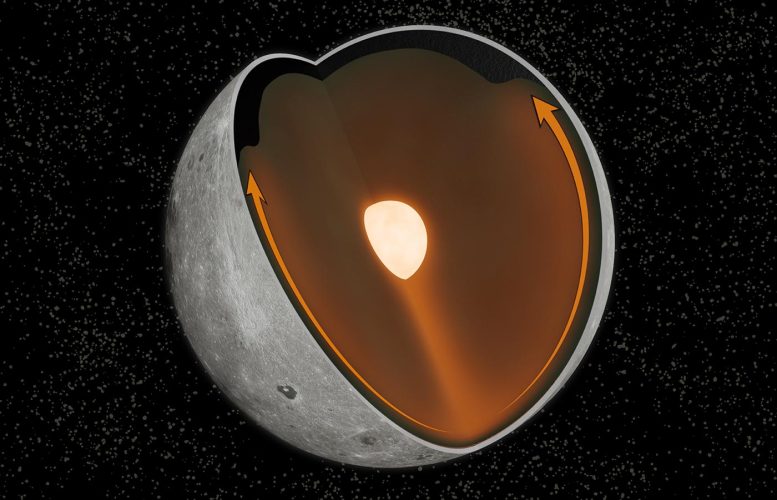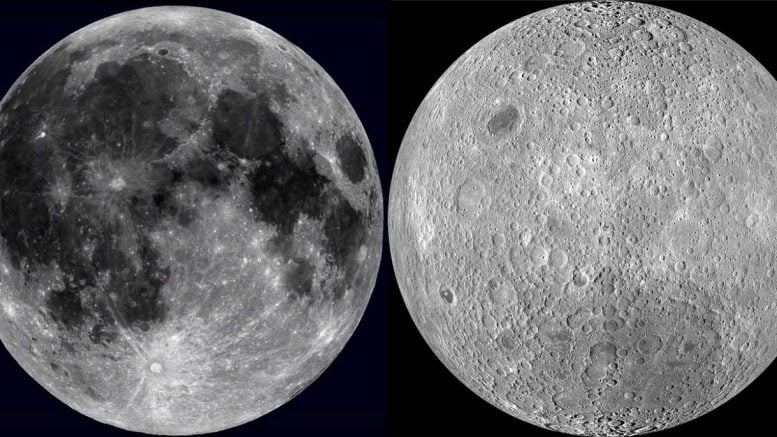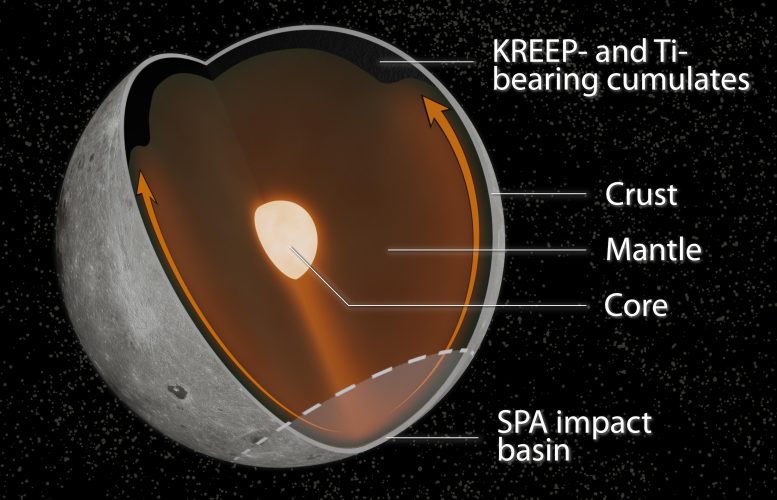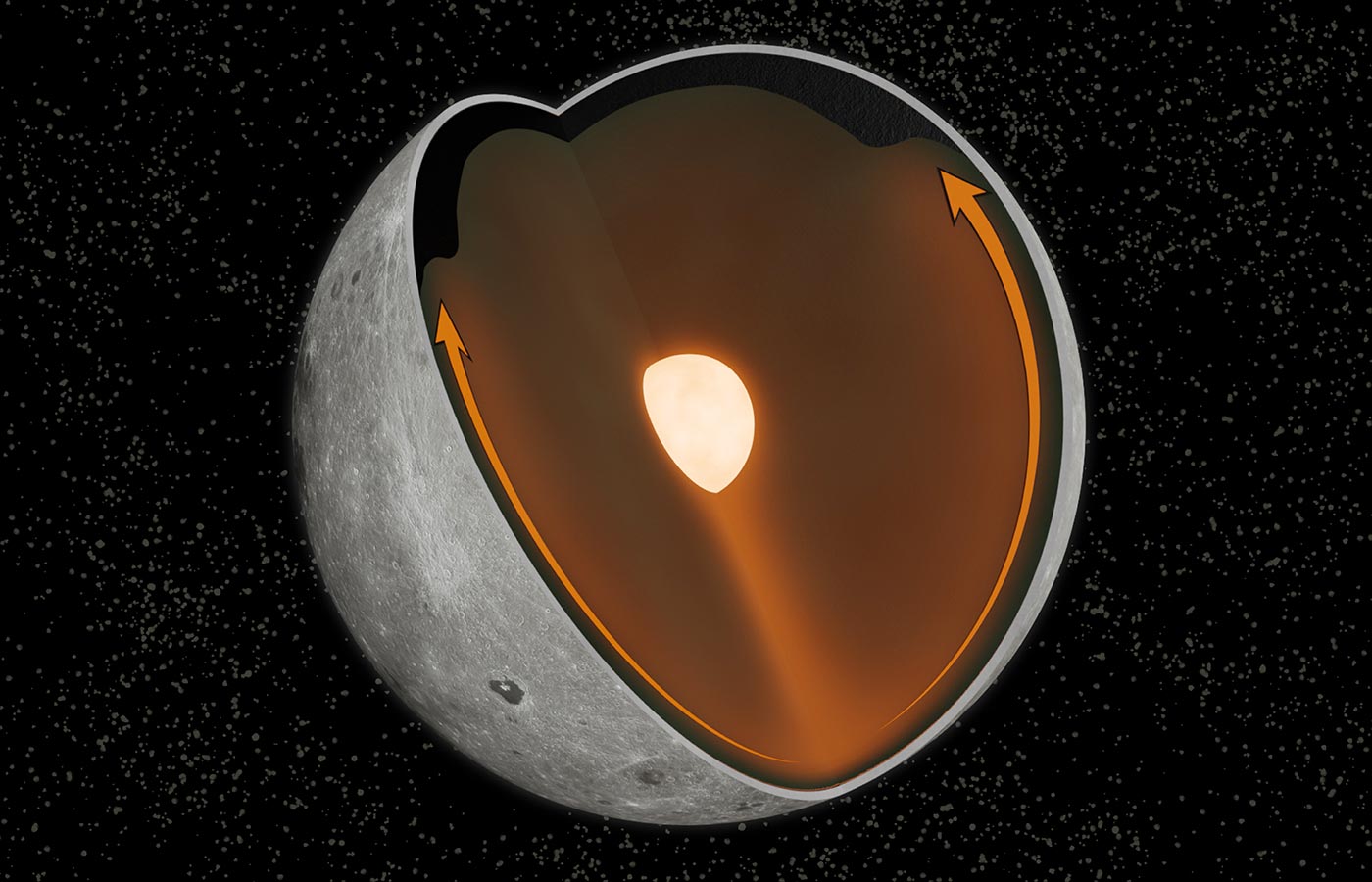
Un nuevo estudio revela que una antigua colisión en el polo sur de la luna ha alterado los patrones de convección en el manto lunar, centrándose en un grupo de elementos productores de calor en el lado cercano. Estos elementos jugaron un papel en la formación de la gran herradura lunar visible desde la Tierra. Crédito: Matt Jones
Una nueva investigación muestra cómo el impacto del Polo Sur-Cuenca Aitken de la Luna está relacionado con el marcado contraste en la composición y apariencia entre los dos lados de la Luna.
La cara que muestra la Luna a la Tierra se ve muy diferente de la que esconde en su cara más alejada. El lado cercano está dominado por persas lunares: los vastos restos de color oscuro de antiguos flujos de lava. Por otro lado, el lado lejano lleno de cráteres está virtualmente desprovisto de características extensas de yeguas. La razón de la gran diferencia entre los dos lados es uno de los misterios más perdurables de la luna.
Ahora, los investigadores tienen una nueva explicación para la luna de dos caras, una explicación relacionada con un impacto gigante hace miles de millones de años cerca del polo sur de la luna.
Un nuevo estudio publicado en Science Advances muestra que el impacto que formó la gigantesca Cuenca Aitken del Polo Sur (SPA) de la luna habría creado una enorme columna de calor que se extendía por el interior de la luna. Este penacho habría contenido ciertos materiales, una combinación de tierras raras y elementos que producen calor, así como la luna cercana. Esta concentración de elementos podría haber contribuido a la actividad volcánica que condujo a la creación de las llanuras volcánicas cercanas.

Extensos depósitos volcánicos dominan el lado cercano de la Luna (izquierda), mientras que el lado lejano (derecha) contiene muchos menos. La razón de la gran diferencia entre los dos lados es el misterio de la luna perpetua. Crédito: Universidad de Brown
“Sabemos que los grandes impactos como el que dio forma al SPA generarán mucho calor”, dijo Matt Jones, Ph.D. Candidato en la Universidad de Brown y autor principal del estudio. La pregunta es cómo afecta esta temperatura a la dinámica interna de la Luna. Lo que mostramos es que bajo cualquier condición razonable en el momento en que se forma la SPA, termina concentrando estos elementos productores de calor en el lado cercano. Especulamos que esto contribuyó al derretimiento del manto que condujo a los flujos de lava que vemos en la superficie. “
El estudio fue una colaboración entre Jones y su asesor, Alexander Evans, profesor asistente en la Universidad de Brown, junto con investigadores de la Universidad de Purdue, el Laboratorio de Ciencias Lunar y Planetaria en Arizona, la Universidad de Stanford y[{” attribute=””>NASA’s Jet Propulsion Laboratory.

A new study reveals that an ancient collision on the Moon’s south pole changed patterns of convection in the lunar mantle, concentrating a suite of heat-producing elements on the nearside. Those elements played a role in creating the vast lunar mare visible from Earth. Credit: Matt Jones
The differences between the near and far sides of the Moon were first revealed in the 1960s by the Soviet Luna missions and the U.S. Apollo program. While the differences in volcanic deposits are plain to see, future missions would reveal differences in the geochemical composition as well. The nearside is home to a compositional anomaly known as the Procellarum KREEP terrane (PKT) — a concentration of potassium (K), rare earth elements (REE), phosphorus (P), along with heat-producing elements like thorium. KREEP seems to be concentrated in and around Oceanus Procellarum, the largest of the nearside volcanic plains, but is sparse elsewhere on the Moon.
Some scientists have suspected a connection between the PKT and the nearside lava flows, but the question of why that suite of elements was concentrated on the nearside remained. This new study provides an explanation that is connected to the South Pole–Aitken basin, the second largest known impact crater in the solar system.
For the study, the researchers conducted computer simulations of how heat generated by a giant impact would alter patterns of convection in the Moon’s interior, and how that might redistribute KREEP material in the lunar mantle. KREEP is thought to represent the last part of the mantle to solidify after the Moon’s formation. As such, it likely formed the outermost layer of mantle, just beneath the lunar crust. Models of the lunar interior suggest that it should have been more or less evenly distributed beneath the surface. But this new model shows that the uniform distribution would be disrupted by the heat plume from the SPA impact.
According to the model, the KREEP material would have ridden the wave of heat emanating from the SPA impact zone like a surfer. As the heat plume spread beneath the Moon’s crust, that material was eventually delivered en masse to the nearside. The team ran simulations for a number of different impact scenarios, from dead-on hit to a glancing blow. While each produced differing heat patterns and mobilized KREEP to varying degrees, all created KREEP concentrations on the nearside, consistent with the PKT anomaly.
The researchers say the work provides a credible explanation for one of the Moon’s most enduring mysteries.
“How the PKT formed is arguably the most significant open question in lunar science,” Jones said. “And the South Pole–Aitken impact is one of the most significant events in lunar history. This work brings those two things together, and I think our results are really exciting.”
Refernece: “A South Pole–Aitken impact origin of the lunar compositional asymmetry” by Matt J. Jones, Alexander J. Evans, Brandon C. Johnson, Matthew B. Weller, Jeffrey C. Andrews-Hanna, Sonia M. Tikoo and James T. Kean, 8 April 2022, Science Advances.
DOI: 10.1126/sciadv.abm8475

“Amante de los viajes. Pionero de Twitter. Ávido gurú de la televisión. Aficionado a Internet galardonado”.

